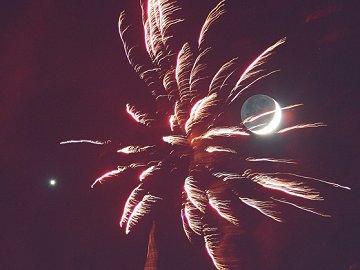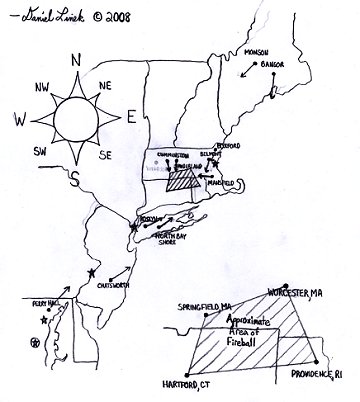| AURORA ALERT: Did you sleep through the northern lights? Next time get a wake-up call: Spaceweather PHONE. | | | LAST AURORAS OF 2008: High-latitude sky watchers should be alert for auroras tonight. A solar wind stream is buffeting Earth's magnetic field and causing geomagnetic storms around the Arctic Circle. Updated: gallery. NEW YEAR'S EVE SKY SHOW: When the sun goes down tonight, step outside and look southwest. Venus and the crescent Moon are having a beautiful close encounter visible through city lights and even fireworks. It's a wonderful way to end the year: sky map. Andreas Möller of Germany sends this photo of the revelries in Europe just a few hours ago: 
"Perfectly aimed, a New Year's rocket exploded right between Venus and the Moon," he says. "I took the picture using my Canon EOS 30D; it is a 2.5 second exposure." more images: from Beery Remon of Arava desert, Israel; from Bader Eddine & Abdellatif Hamdi of Debila, Eloued, Algeria; from Carl Blesch of Basking Ridge, New Jersey; from P-M Hedén of Tänndalen, Sweden; from Mac Libid at the Eternal Gardens in Dagupan City, the Philippines; from Karen Schmeets of Manassas, Virginia; from Morten Ross of Sandbukta, Norway; from Anton Balatskiy of Port Provideniya, Chukotka, Russia; from Hassan Alsabbar of Diwaniya, Iraq; from Paco Burguera Catalá of Valencia, Spain; from Terry Tedor of North Pole, Alaska; from Babak Tafreshi of Dasht-e Kavir (Great Salt Desert), Iran; from David Williams of Frederick, Maryland; from Gary A. Becker of Coopersburg, Pennsylvania; from Alan C Tough of Elgin, Moray, Scotland; from Martin Mc Kenna of Maghera, Co. Derry, N. Ireland; from Žiga Golobič of Pokljuka, Slovenia; NEW ENGLAND FIREBALL: On Dec. 29th, around 9:30 pm EST, a blue-green fireball 100+ times brighter than Venus soared over New England and exploded colorfully in mid-air. Onlookers saw the flash from at least nine US states: eye-witness reports. Dan Linek of North Bay Shore, New York, was one of the eye witnesses. Combining his own observations with those of others, he created a hand-drawn map of sightings and the probable location of the fireball when it exploded: 
If any fragments reached the ground, they might have landed in the western half of Linek's trapezoid. (The meteor was traveling east to west.) Believe it or not, meteors like this are not rare--they are just rarely seen. Fireballs a hundred times brighter than Venus streak over some part of Earth once every day or so. The vast majority are never noticed. About 70% streak over uninhabited ocean. Half appear during the day, invisible in sunny skies. Many are missed simply because they occur in the middle of the night when sky watchers are asleep. The New England fireball stands out because it hit a densely populated area only a few hours after sunset. It was bound to be seen. No one can predict where the next fireball will appear, so keep looking up!
UPDATED: Dec. 2008 Nacreous Cloud Gallery
[January 2008 Gallery] [Nacreous tutorial] | 
